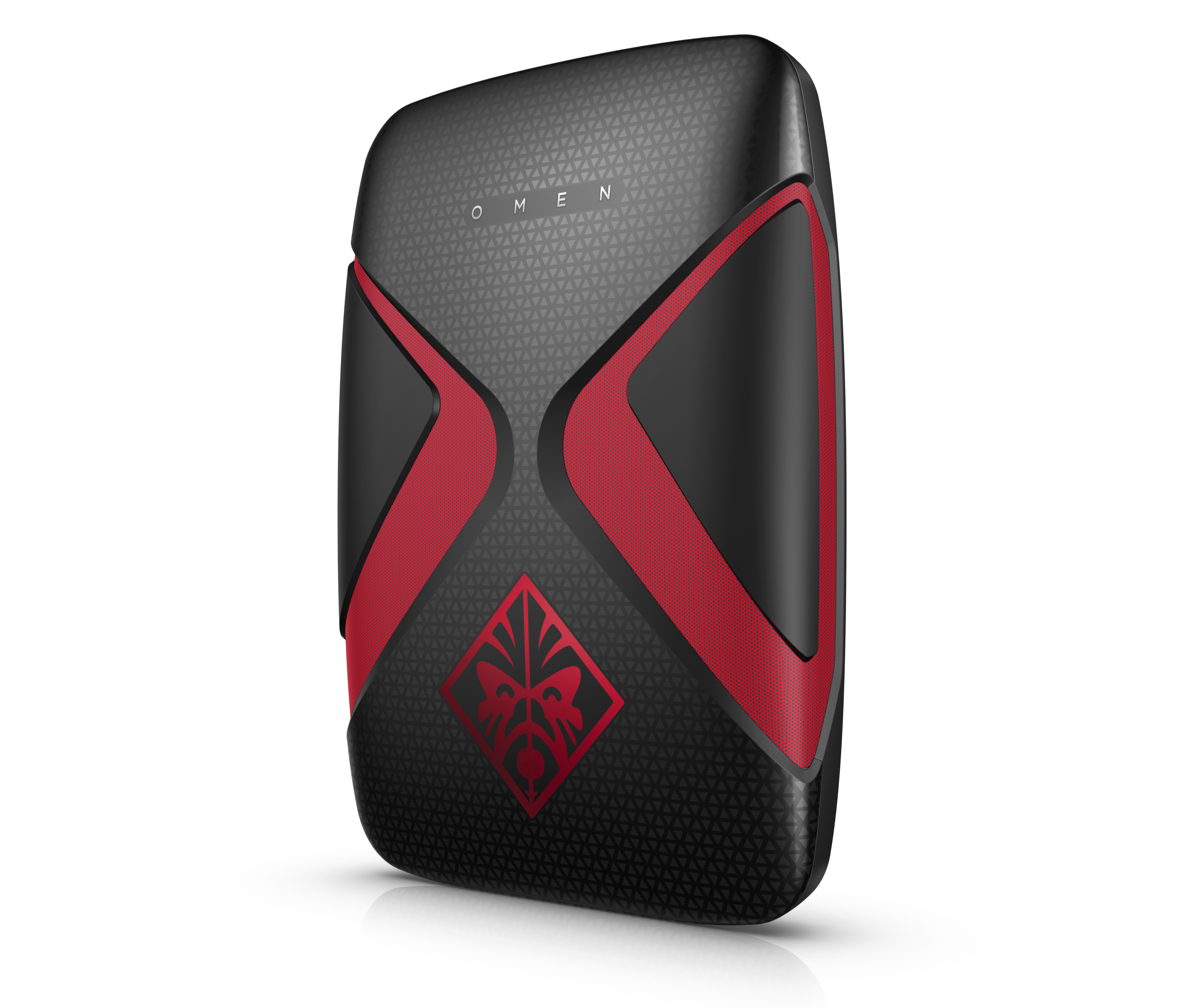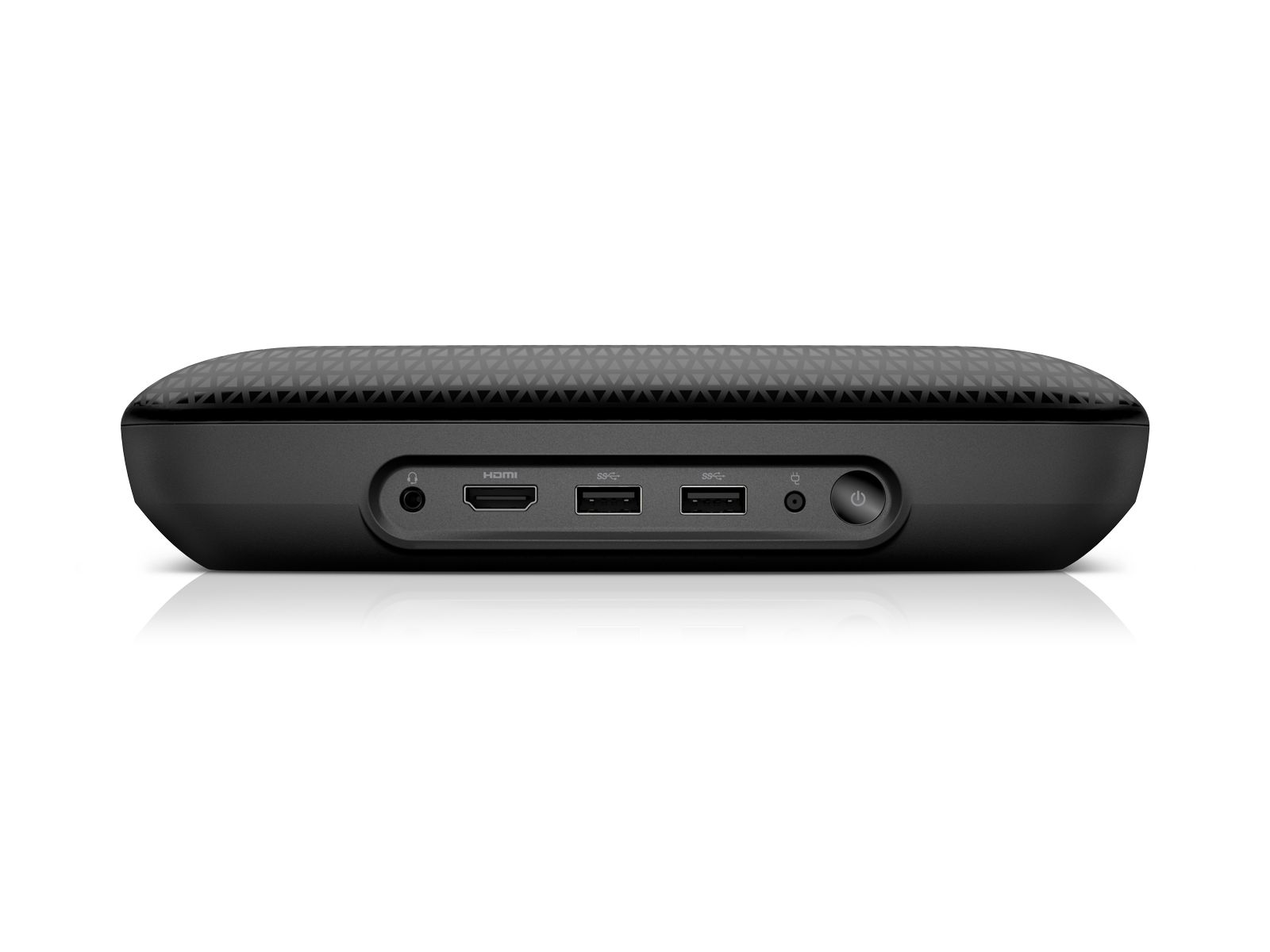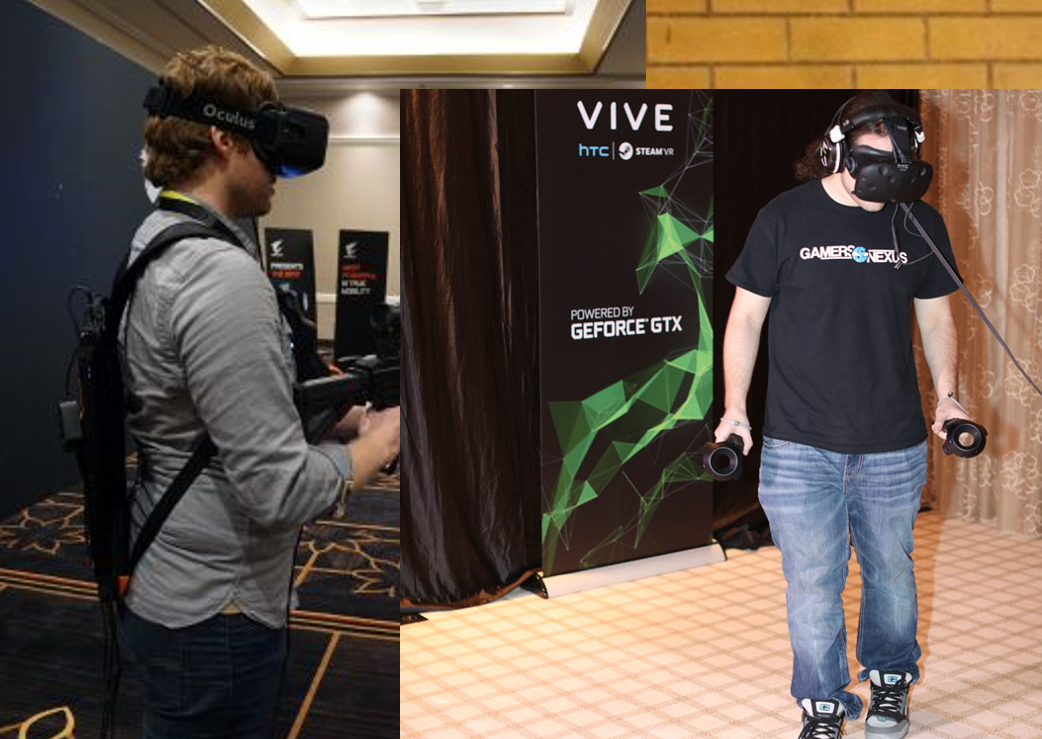HP Omen’s Dark (And Red) Secret: The Omen X VR PC Pack
HP recently announced a renewed aggression in the consumer gaming PC market with its new Omen lineup, consisting of laptops, desktops and a QHD display. However, as the company proudly showcased the Omen offerings, HP was hiding a dark (and red) secret behind its back. Err, on its back.
The HP Omen X VR PC Pack Hardware Development Kit is a concept PC that can be strapped on your back. It weighs less than 10 lbs., and although the full specifications are not yet available, we do know it sports Intel’s latest 6th generation (Skylake) quad-core i5 and i7 H-series processors.
Storage comes in the form of M.2 SSDs, up to 512 GB each (but there’s no word on how many you can fit), and the Omen X VR PC Pack can be equipped with up to 32 GB of DDR4 memory. At this time, we don’t know which GPU (or GPUs) are inside the Omen X VR PC Pack; it will be interesting to see if HP will offer a VR-ready GTX 980 MXM graphics module or more-powerful full-size desktop GPUs.
The backpack is designed to free VR users from the confines of cables tethered to a stationary PC and from getting tangled in a mess of wires, which is especially useful for high-energy and fast-paced VR games (anyone try Hover Junkers or Holopoint yet?).
The power button resides at the top of the device along with two USB 3.0 ports and an HDMI output, which is the minimum connectivity required for the Oculus Rift. However, connecting the HTC Vive to any PC requires the link box, which is powered by a standard 5V adapter. The Omen X VR PC Pack features a single DC-out jack, but HP said this is just for headphone power.
If that’s the case, in order to truly roam free with an HTC Vive, you will have to find an external battery to power the link box, not to mention find a place for it on your back along with the jungle of excess cables from the HMD and the link box. All of HP’s materials on the Omen X VR PC Pack featured photos of Rift-equipped implementations (save the one photo of someone tangled in the Vive’s cables, as a testimonial). Hopefully, this isn’t indicative that HP left out the Vive and its room-scale VR. Perhaps HTC or HP will make an external power source for the Vive to bypass the link box as VR implementations like this become more common (cough, get on it guys, cough).
One of the drawbacks to the increased immersion from the lack of a tether is the lack of time you can spend in it – the battery lasts only up to one hour. The run time may seem like a downer, but there’s a good reason the attached external battery drains that quickly. In most consumer gaming laptops, the CPU and GPU have to throttle because of limited wattage output from the battery. HP’s Omen X VR PC Pack features high-output batteries that deliver the full wattage to the components, providing full, unrestricted performance.
Get Tom's Hardware's best news and in-depth reviews, straight to your inbox.
Nobody likes gaming on a timer, so in order to reduce the downtime that an hour of power could facilitate, the HP Omen X VR PC Pack can carry up to two more hot-swappable (that’s right, mid-game) batteries. This is achieved with a small internal battery, which will keep the system running while you swap power sources.
Although the Omen X VR PC Pack is designed to be worn on the back, HP made the case that it can double as an ultra-portable and powerful desktop. Peripherals can be attached wirelessly for typing and navigation (mouse), in addition to wireless display connectivity, which can be used while it’s still strapped to your back in order to access Windows functions without removing equipment. (We were wondering how it could navigate Windows with just an HMD – it seems that it can’t.)
The HP Omen X VR PC Pack will be available for developers in 30 days, but currently there’s no word on what the backpack VR gaming rig will cost.
Derek Forrest is an Associate Contributing Writer for Tom’s Hardware and Tom’s IT Pro. Follow Derek Forrest on Twitter. Follow us on Facebook, Google+, RSS, Twitter and YouTube.
Derek Forrest was a contributing freelance writer for Tom's Hardware. He covered hardware news and reviews, focusing on gaming desktops and laptops.
-
niz >> connecting the HTC Vive to any PC requires the link box,Reply
Totally not true. It works just fine when plugged directly into the PC without the linkbox in between. -
kewlguy239 Reply>> connecting the HTC Vive to any PC requires the link box,
Totally not true. It works just fine when plugged directly into the PC without the linkbox in between.
Then how do you power the HMD without connecting that third DC-IN plug from the Vive?
-
photonboy this would be really appealing if they get the size down quite a bit. Maybe about double the volume of a Mac Mini, with half that battery. A Zen/Polaris, 14nm APU with 16GB GDDR5X or HBM2 would be pretty interesting.Reply
Maybe a desktop stand that you can tuck the straps into so to use you can pick up and put on like a small backpack, or hip pack depending on the size. -
niz >> connecting the HTC Vive to any PC requires the link box,Reply
Totally not true. You can plug the headset straight into your PC and it works fine. -
Samer1970 Yea suuure .. Carry this monster on your back playing for hours and you will end up having Cancer , kidney failure , Heart problems , brain problems , and maybe worse.Reply
who on earth can stand FULL LOAD 3GHZ CPU , 2GHZ GTX 980 , running at 350 watts minimum and emitting electromagnetic waves for hours near his internal organs .
HP , MSI and all of you , STOP IT ! or you will pay BILLIONS after 20 years to compensate sick pope ...
If you want to do it RIGHT then use Wifi instead of USB3 and HDMI connections...
or dont do it at all !
look at this stupid OMEN it is not even SHIELDED ! -
grimfox ...yeah...that's not how this works. That's not how EMF radiation works at all. First of all most highspeed busses are shielded to begin with to avoid interference from the outside. This shielding works in both directions. It keeps noise out but also keeps noise in. Secondly Wifi especially wifi capable of transmitting 90hz HD video would be operating at a higher frequency than the busses or chips operating in that backpack. You're more likely to get burns from that thing than cancer or any sort of radiation illness, as there is effectively 300+W concentrated into small space with what appears to be very little ventilation.Reply
I'm disappointed with the run time but the hot swap batteries are exactly what is needed here. Especially if they can be fully charged in the same time it takes to drain one.
I looked at building something like this for myself using a Skullcanyon NUC and a external PCI-E enclosure. But I couldn't find the enclosure for a decent price. Batteries are another source of great expense. This is really a great start but I think they could have put a bit more into the connectivity. -
Samer1970 Reply18047909 said:...yeah...that's not how this works. That's not how EMF radiation works at all. First of all most highspeed busses are shielded to begin with to avoid interference from the outside. This shielding works in both directions. It keeps noise out but also keeps noise in. Secondly Wifi especially wifi capable of transmitting 90hz HD video would be operating at a higher frequency than the busses or chips operating in that backpack. You're more likely to get burns from that thing than cancer or any sort of radiation illness, as there is effectively 300+W concentrated into small space with what appears to be very little ventilation.
I'm disappointed with the run time but the hot swap batteries are exactly what is needed here. Especially if they can be fully charged in the same time it takes to drain one.
I looked at building something like this for myself using a Skullcanyon NUC and a external PCI-E enclosure. But I couldn't find the enclosure for a decent price. Batteries are another source of great expense. This is really a great start but I think they could have put a bit more into the connectivity.
use your 3v 5 watts phone for 1 hour and your ears will turn red ... from the signal near your head ... I even dont trust smart phones when it come to health
This machine will make people sick ... and we will know when it is too late.
it is too eary for portable VR ... we need 10 more years for that , when a GTX 1080 equivalent runs inside mobile phones TDP 5 watts.
for now , we use wires ..
by the way , you can mount the pc on the ceiling with all cables coming down , and make them spring like wires to extend when you walk around . Thats the best solution IMO
-
grimfox Reply18048055 said:18047909 said:.snip.
use your 3v 5 watts phone for 1 hour and your ears will turn red ... from the signal near your head ... I even dont trust smart phones when it come to health
This machine will make people sick ... and we will know when it is too late.
it is too eary for portable VR ... we need 10 more years for that , when a GTX 1080 equivalent runs inside mobile phones TDP 5 watts.
for now , we use wires ..
by the way , you can mount the pc on the ceiling with all cables coming down , and make them spring like wires to extend when you walk around . Thats the best solution IMO
I'm sure it has nothing to do with the heat of the phone or the lack of ventilation caused by having your phone planted next to your ear for such an extended time. /sarcasm As a test set your phone to airplane mode and start a looping benchmark or other task and hold your phone to your ear, see if your ear doesn't turn red in such a situation as well.
I understand there was recently some scare-media going around about a "study" that showed cellular radiation at 900mhz was cancer causing. The media reported on this but failed to mention that the study had some major flaws like their control group of rats died (the ones not intentionally exposed to cellular radiation) and that it wasn't properly peer-reviewed and that those that did peer-review it found it to be lacking the substance of good science. We should also be clear that this is not a cellular device. It is a high powered laptop. Don't you think if such a device is capable of causing cancer we would have already seen many cases of people developing cancer in their extremities related to laptop use? Certainly we've seen people burned by the heat and probably some people have been injured by exploding batteries. These things are causes for concerns not EMF spawned cancer.
I've also looked at developing an arm for holding the cable up. Buying them from the industrial or medical sectors is shockingly expensive, easiliy 10 times the cost of the HUD. I think the main gripe about the arm is that it is going to require an "installation" whereas the backpack is more flexible (ignoring the beacons or cameras required for either instance). -
Samer1970 Reply18054067 said:18048055 said:18047909 said:.snip.
use your 3v 5 watts phone for 1 hour and your ears will turn red ... from the signal near your head ... I even dont trust smart phones when it come to health
This machine will make people sick ... and we will know when it is too late.
it is too eary for portable VR ... we need 10 more years for that , when a GTX 1080 equivalent runs inside mobile phones TDP 5 watts.
for now , we use wires ..
by the way , you can mount the pc on the ceiling with all cables coming down , and make them spring like wires to extend when you walk around . Thats the best solution IMO
I'm sure it has nothing to do with the heat of the phone or the lack of ventilation caused by having your phone planted next to your ear for such an extended time. /sarcasm As a test set your phone to airplane mode and start a looping benchmark or other task and hold your phone to your ear, see if your ear doesn't turn red in such a situation as well.
I understand there was recently some scare-media going around about a "study" that showed cellular radiation at 900mhz was cancer causing. The media reported on this but failed to mention that the study had some major flaws like their control group of rats died (the ones not intentionally exposed to cellular radiation) and that it wasn't properly peer-reviewed and that those that did peer-review it found it to be lacking the substance of good science. We should also be clear that this is not a cellular device. It is a high powered laptop. Don't you think if such a device is capable of causing cancer we would have already seen many cases of people developing cancer in their extremities related to laptop use? Certainly we've seen people burned by the heat and probably some people have been injured by exploding batteries. These things are causes for concerns not EMF spawned cancer.
I've also looked at developing an arm for holding the cable up. Buying them from the industrial or medical sectors is shockingly expensive, easiliy 10 times the cost of the HUD. I think the main gripe about the arm is that it is going to require an "installation" whereas the backpack is more flexible (ignoring the beacons or cameras required for either instance).
no need for that , all what you need is to DIY spring cables and connect them to the PC , use screw plugs as well so they Dont fall .
no need for expensive hardware at all ...
cheap and Easy . the spring cables will stretch when you move away from the center . mount the pc on the ceiling , -
photonboy Portable VR:Reply
Some confusion here... what they are selling is a DEVELOPER KIT. It's meant for developing content for when VR becomes more portable.
So you strap on the backpack, put on a HUD (with camera) and then walk around. With the built-in camera you can mix then OVERLAY information onto the real world. This has non-gaming uses as well which were described by the Google Glass project. Probably most cases would be non-gaming, though virtual Frogger might be interesting...


